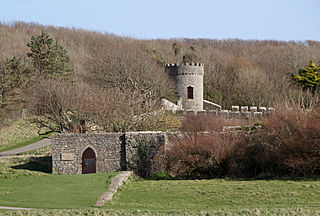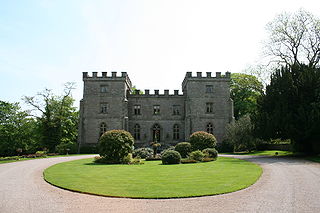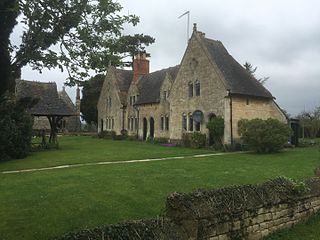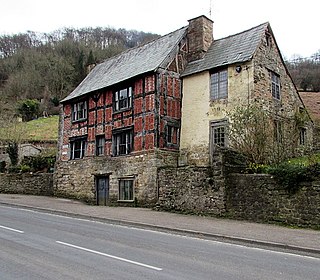
Deerhurst is a village and civil parish in Gloucestershire, England, about 2 miles (3 km) southwest of Tewkesbury. The village is on the east bank of the River Severn. The parish includes the village of Apperley and the hamlet of Deerhurst Walton. The 2011 Census recorded the parish's population as 906, the majority of whom live in Apperley.

Gloucester Cathedral, formally the Cathedral Church of St Peter and the Holy and Indivisible Trinity and formerly St Peter's Abbey, in Gloucester, England, stands in the north of the city near the River Severn. It originated with the establishment of a minster, Gloucester Abbey, dedicated to Saint Peter and founded by Osric, King of the Hwicce, in around 679.

Dumbleton is a village and civil parish in the Tewkesbury district, in the county of Gloucestershire, England. The village is roughly 20 miles from the city of Gloucester. The village is known to have existed in the time of Æthelred I who granted land to Abingdon Abbey, and it is mentioned in the Domesday Book.

Clearwell is a village and former ancient manor in the Forest of Dean, West Gloucestershire, England. A recent survey indicated that the population of Clearwell is approximately 350.

Roger Morris was an English architect whose connection with Colen Campbell brought him to the attention of Henry Herbert, 9th Earl of Pembroke, with whom Morris collaborated on a long series of projects.

Miserden is a village and civil parish in Stroud District, Gloucestershire, England, 4 miles north east of Stroud. The parish includes Whiteway Colony and the hamlets of Sudgrove and The Camp. In the 2001 census the parish had a population of 420, increasing to 449 at the 2011 census.

Purton is a hamlet on the west bank of the River Severn, in the civil parish of Lydney in Gloucestershire, England. It lies opposite the village of Purton near Berkeley on the east bank of the river.

Forthampton is a village in Gloucestershire, England. The village is located three miles from the market town of Tewkesbury and features "a great number of interesting buildings", fine views, several duck ponds, a church, a collection of thatched cottages and farmsteads, a village hall and a village club. Forthampton was designated a Conservation Area in 2003 due to its special architectural and historic interest, character and appearance which it was desirable to preserve and enhance. Notable features of the village include extensive historic buildings clustered around farm houses situated at the centre of the village, the many roadside ponds and grass verges around and between buildings and significant panoramic views.

St Saviour's Church is a historic 19th-century Anglican church in the town of Tetbury, Gloucestershire, England under the care of The Churches Conservation Trust. It was designed by the architect Samuel Daukes. Augustus Welby Northmore Pugin and John Hardman undertook the design and execution of the chancel roof. St Saviour's is recorded in the National Heritage List for England as a designated Grade II* listed building.

Dunraven Castle was a mansion on the South Wales coast near Southerndown. The existing manor house was rebuilt as a castellated hunting lodge in the early 19th century and was extensively remodelled later in the century. The surviving parts of the house are a Grade II listed building and its gardens and park are designated Grade II on the Cadw/ICOMOS Register of Parks and Gardens of Special Historic Interest in Wales.

St Mary of the Angels Church is located to the south of the village of Brownshill in the parish of Chalford, Gloucestershire, England. It is a redundant Roman Catholic church vested in the Friends of Friendless Churches. The church is recorded in the National Heritage List for England as a designated Grade II listed building.

Daylesford House is a Georgian country house near Daylesford, Gloucestershire, England, on the north bank of the River Evenlode near the border with Oxfordshire, 5 miles (8.0 km) east of Stow-on-the-Wold and 5 miles (8.0 km) west of Chipping Norton. The village of Daylesford lies nearby to the west, Adlestrop to the north, Cornwell to the east, and Kingham to the south,

Thomas Wyndham of Clearwell Court, Gloucestershire, Dunraven Castle, Glamorgan, and Cromer, Norfolk, was a British lawyer and politician who sat in the House of Commons from 1721 to 1734.

Hillfield House is a grade II listed house in Denmark Road, Gloucester, in England. The building, in the Italianate style popularised by Charles Barry, is faced in ashlar Bath stone, with a centrally placed tower and a porte-cochère entrance.

Wick Court is a country house in the parish of Arlingham, Gloucestershire, England, 0.5 mile east of the hamlet of Overton. It was constructed between the late 14th and the mid-17th centuries. Now a base for the charity Farms for City Children, it operates as a traditional livestock farm providing experience of country life for children from urban areas. Wick Court is a Grade II* listed building.

Lechlade Manor in Lechlade, Gloucestershire, England, is a Victorian country house built for George Milward, a lawyer, by John Loughborough Pearson. Primarily an ecclesiastical architect, working on over 200 church buildings in his fifty-year career, the manor represents one of Pearson's rare forays into secular building. Dating from 1872 to 1873, Lechlade was subsequently sold to the Sisters of St Clotilde and operated as a convent for much of the 20th century. In the 1990s, it was converted back to a private residence, with some enabling development in the grounds. Lechlade Manor is a Grade II listed building.

The Church of St Mary and St Peter, Tidenham, is a parish church of the Diocese of Gloucester, England. It dates from the 13th and 14th centuries, and was extensively restored by John Norton in 1858. It is a Grade II* listed building and remains an active parish church.

The Yorke Almshouses, Nos. 14–17 Church Row, Forthampton, Gloucestershire, England, are a range of four almshouses designed by the architect William Burges in 1865. The block is a Grade II listed building and the almshouses remain private residences.
Piers Court is a country house in Stinchcombe on the Cotswold Edge in Gloucestershire, England. A Grade II* listed building, in the mid-20th century the court was home to the novelist Evelyn Waugh.

Sarah Siddons' House, also called the Old House, is a cottage in the village of Lydbrook, Gloucestershire, England. A Grade II* listed building, the cottage was reputedly the childhood home of the actor Sarah Siddons.





















